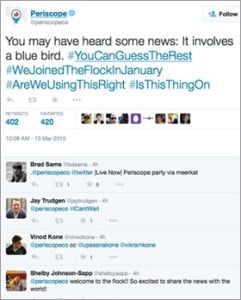
Twitter’s acquisition of Periscope is a strategy on their part to get ahead of this trend and leverage their vast social graph to video-enable tweets.
What 140 characters may limit you to say, a video may be worth a thousand words. “I can tell you, but it’ll be better if I show you,” is the new mantra.
At South by Southwest 2015, these live streaming apps have gone viral and become a major topic of conversation.
The Disruption of Live Video Streaming
Live video streaming represents a huge disruption as it brings real-time user generated content that is completely visual. Once a user touches the equivalent of a “stream now” button on their smartphone, whatever is in view of the phone’s camera is then broadcast to all. This places tremendous power into users’ hands to report and broadcast news on anything, anywhere they are. The media impact is unfathomable.
So, it makes sense Twitter is getting involved with the Periscope acquisition, which was confirmed Friday, March 13th, 2015. What also makes sense is that Twitter announced per policy limitations to Meerkat’s access to Twitter and it’s social graph for live video streaming. This limits Meerkat users from live streaming with Twitter followers.
The Battle for Live Video Streaming Dominance
We don’t believe this will completely stop Meerkat, but it will halt progress. What the Twitter restriction really means is that when users sign on to Meerkat, they won’t be automatically connected to the people they follow on Twitter. Users will have to manually build their network. We believe Meerkat will now have to focus on building its own social network and social graph.
Stre.am is the other live streaming app that is getting a lot of attention. Stre.am allows users to sign in with their Facebook, Twitter, Google+, and email accounts. They can also share live video streams from the same, including via SMS.
In fact, Stre.am is up for an innovation award at South by Southwest. With Stre.am, people can interact in real-time and directly message the individual broadcasting the video stream. While Meerkat streams are only live and can’t be accessed when it’s over, Stre.am allows broadcasters to record and share their videos for a whole day after it’s recorded. Interestingly enough, Periscope will allow on-demand replay of videos.
Speaking of Periscope, as it will allow on-demand replay of recorded videos, it will no doubt have the full integration of the Twitter network and social graph. Periscope has not yet launched, but we believe it will broaden Twitter’s capabilities from text and images to include real-time video. This will enhance the depth of content users can generate and publish. Periscope video viewers will be able to comment on video streams which will surface so the broadcaster and others can see.
Final Thoughts
With Twitter now in this space, the big issue that will surface is monitoring. Live video streams are near real-time and will be difficult to monitor or keep up with, even as critical mass is reached. Flagging content in real-time will be a tall order, requiring tons of resources. Twitter’s success with Periscope will depend on the network effect and how big a community of content creators can blossom.
Other live video streaming apps will emerge and create further competition. It will be interesting to see what moves Google, Facebook, and even Apple make in this emerging space.